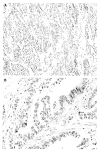Pathological features of colorectal carcinomas in MYH-associated polyposis
- PMID: 18564191
- PMCID: PMC2754312
- DOI: 10.1111/j.1365-2559.2008.03071.x
Pathological features of colorectal carcinomas in MYH-associated polyposis
Abstract
Aims: MYH is a DNA glycosylase in the base excision repair pathway. Germ-line biallelic mutations in the MYH gene are associated with the development of multiple colorectal adenomas and colorectal carcinoma (CRC). A slightly increased risk of CRC is suggested in monoallelic MYH mutation carriers. The aim was to characterize the histopathological features of carcinomas from biallelics and monoallelics.
Methods and results: Clinicopathological features of 57 colorectal carcinomas from 50 patients identified in familial CRC registries were recorded. These included 16 cancers from 14 MYH biallelics; 25 cancers from 22 MYH monoallelics; and 16 cancers from 14 controls. Carcinomas in biallelics demonstrated tubular, papillary or cribriform patterns as the predominant histological subtype, and main histological groups differed according to mutation status (P = 0.0053). All biallelic cancers were low grade, with high-grade tumours more common in monoallelics and controls (P = 0.002). Synchronous polyps were observed in 75% of biallelics, 33% of monoallelics and 43% of controls (P = 0.035). Serrated carcinoma was the predominant type in 12% (3/25) of the monoallelics but in none of the biallelics or controls. MYH immunohistochemistry failed to distinguish between groups.
Conclusions: Neither pathological features nor immunohistochemistry could predict the MYH mutation status of CRCs in this study.
Figures


References
-
- Al Tassan N, Chmiel NH, Maynard J, et al. Inherited variants of MYH associated with somatic G:C->T:A mutations in colorectal tumors. Nat. Genet. 2002;30:227–232. - PubMed
-
- Lipton L, Halford SE, Johnson V, et al. Carcinogenesis in MYH-associated polyposis follows a distinct genetic pathway. Cancer Res. 2003;63:7595–7599. - PubMed
-
- Sieber OM, Lipton L, Crabtree M, et al. Multiple colorectal adenomas, classic adenomatous polyposis, and germ-line mutations in MYH. N. Engl. J. Med. 2003;348:791–799. - PubMed
-
- Kanter-Smoler G, Bjork J, Fritzell K, et al. Novel findings in Swedish patients with MYH-associated polyposis: mutation detection and clinical characterization. Clin. Gastroenterol. Hepatol. 2006;4:499–506. - PubMed
Publication types
MeSH terms
Substances
Grants and funding
LinkOut - more resources
Full Text Sources
Medical
Research Materials

